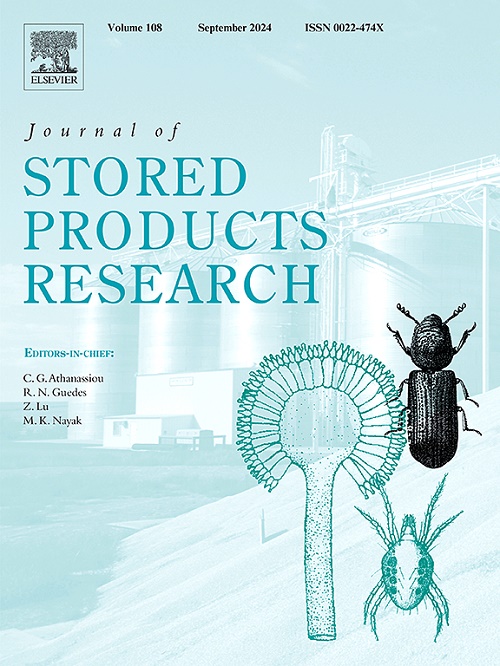二氧化硅对储粮害虫米象虫(鞘翅目:米象虫科)的影响及其对小麦籽粒的残留影响
IF 2.7
2区 农林科学
Q1 ENTOMOLOGY
引用次数: 0
摘要
小麦(Triticum aestivum L.)是全球重要的主要作物。尽管如此,稻谷象鼻虫(Sitophilus oryzae L.)等害虫造成的收获后损失严重影响了粮食质量和储存。传统的虫害防治方法,特别是化学杀虫剂,对环境和健康构成风险,因此迫切需要更安全的替代品。本研究评价了硅纳米颗粒对象鼻虫的防治效果,并研究了其对小麦籽粒的残留和理化效应。以不同浓度的硅粉为对照,以未经处理的颗粒为对照,进行了室内试验。在15天内,记录了死亡率、粮食重量损失和损害情况。结果表明,较高浓度的硅,特别是700和1000 ppm,可在5天内使害虫完全死亡。在这些浓度下,体重损失和谷物损害都显著减少,在1000ppm时,体重损失最低,为0.50%,损害最低,为0.44%。此外,该研究还检测了硅处理颗粒的物理化学性质,包括水分含量、体积密度、孔隙率和吸水率。储存第1天和第180天分别进行测量。在处理和未处理的谷物中发现了贮藏引起的变化,但未发现对谷物品质的不利影响。使用扫描电子显微镜-能量色散x射线能谱法分析残余硅,确认在两次洗涤后有效去除,确保处理后的晶粒符合安全标准。总之,这些发现表明,硅纳米颗粒代表了一种有前途的、无残留的、环境可持续的收获后有害生物管理方法,可以有效地保持粮食质量,同时减轻有害生物造成的损失。本文章由计算机程序翻译,如有差异,请以英文原文为准。

Effects of silica on stored product pest, Sitophilus oryzae L. (Coleoptera: Curculionidae) and its residual impact on Triticum aestivum L. grain
Wheat (Triticum aestivum L.) is a crucial global staple crop. Still, post-harvest losses caused by insect pests, such as the rice weevil (Sitophilus oryzae L.), significantly compromise grain quality and storage. Conventional pest control methods, particularly chemical insecticides, pose environmental and health risks, highlighting the urgent need for safer alternatives. This study assessed the efficacy of silicon nanoparticles in controlling weevil infestations and investigated their residual and physicochemical effects on wheat grains. Laboratory experiments were conducted using silicon powder at various concentrations, with untreated grains as control. Over 15 days, mortality rates, grain weight loss, and damage were recorded. The results demonstrated that higher concentrations of silicon, particularly 700 and 1000 ppm, achieved complete pest mortality within 5 days. Both weight loss and grain damage were significantly reduced at these concentrations, with the lowest rates observed at 0.50 % for weight loss and 0.44 % for damage at 1000 ppm. Additionally, the study examined the physicochemical properties of the silicon-treated grains, including moisture content, bulk density, porosity, and water uptake. The measurements were taken on the first day and again on the 180th day of storage. While storage-induced changes were noted in treated and untreated grains, no adverse impacts on grain quality were identified. Residual silicon analysis using scanning electron microscopy-energy dispersive X-ray spectroscopy confirmed effective removal following double washing, ensuring the treated grains comply with safety standards. In conclusion, the findings suggest silicon nanoparticles represent a promising, residue-free, and environmentally sustainable approach to post-harvest pest management, effectively preserving grain quality while mitigating pest-induced losses.
求助全文
通过发布文献求助,成功后即可免费获取论文全文。
去求助
来源期刊
CiteScore
5.70
自引率
18.50%
发文量
112
审稿时长
45 days
期刊介绍:
The Journal of Stored Products Research provides an international medium for the publication of both reviews and original results from laboratory and field studies on the preservation and safety of stored products, notably food stocks, covering storage-related problems from the producer through the supply chain to the consumer. Stored products are characterised by having relatively low moisture content and include raw and semi-processed foods, animal feedstuffs, and a range of other durable items, including materials such as clothing or museum artefacts.

 求助内容:
求助内容: 应助结果提醒方式:
应助结果提醒方式:


